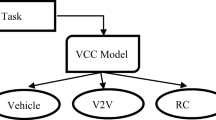Abstract
Vehicular communication becomes an advanced area of research to deliver services to the users like standardization, traffic management and road safety, infotainment and entertainment. Vehicles carry communication modules, computing facility, storage, Internet accessing capability and equipped with application specific sensors in the on-board unit. Recently, vehicular cloud computing is a technology that is embedded with vehicular networks to solve many vehicular networking issues and challenges like storage, computing, information gain, internet access, network, security, etc. In this paper, we consider the storage as a service (STaaS) issue in vehicular networks. The vehicles in the parking lots are used as a data center to store the information of the user. However, providing this service to the users requires a scheduling policy to give the storage service in a minimum time. Therefore, we develop a new scheduling policy, called TSP-HVC for STaaS in the vehicular cloud environment. The simulation results show that the proposed scheduling policy produces less makespan and high average resource utilization than the well-known min–min and max–min cloud scheduling policies.



Similar content being viewed by others
References
Zheng K, Meng H, Chatzimisios P, Lei L, Shen X (2015) An SMDP-based resource allocation in vehicular cloud computing systems. IEEE Trans Industr Electron 62(12):7920–7928
Bitam S, Mellouk A, Zeadally S (2015) VANET-cloud: a generic cloud computing model for vehicular ad hoc networks. IEEE Wirel Commun 22(1):96–102
Lee E, Lee E, Gerla M, Oh S (2014) Vehicular cloud networking: architecture and design principles. IEEE Commun Mag 52(2):148–155
Zeadally S, Hunt R, Chen Y, Irwin A, Hassan A (2012) Vehicular ad hoc networks (VANETS): status, results and challenges. Telecommun Syst 50(4):217–241 (Springer)
Bhoi S, Khilar P (2016) RVCloud: a routing protocol for vehicular ad hoc network in city environment using cloud computing. Wirel Netw 22(4):1329–1341 (Springer)
Gerla M (2012) Vehicular cloud computing. In: the 11th annual Mediterranean ad hoc networking workshop, IEEE, pp 152–155
Whaiduzzaman M, Sookhak M, Gani A, Buyya R (2014) A survey on vehicular cloud computing. J Netw Comput Appl 40:325–344 (Elsevier)
Son J, Eun H, Oh H, Kim S, Hussain R (2012) Rethinking vehicular communications: merging VANET with cloud computing. In: IEEE 4th international conference on cloud computing technology and Science, pp 606–609
Panda S, Jana P (2015) Efficient task scheduling algorithms for heterogeneous multi-cloud environment. J Supercomput 71(4):1505–1533 (Springer)
Fang Y, Wang F, Ge J (2010) A task scheduling algorithm based on load balancing in cloud computing. In: web information systems and mining, Springer, pp 271–277
Panda S, Gupta I, Jana P (2017) Task scheduling algorithms for multi-cloud systems: allocation-aware approach. Information systems frontiers. Springer, New York, pp 1–19
Panda S, Jana P (2017) SLA-based task scheduling algorithms for heterogeneous multi-cloud environment. J Supercomput 73(6):2730–2762 (Springer)
Panda S, Jana P (2016) Uncertainty-based QoS min–min algorithm for heterogeneous multi-cloud environment. Arab J Sci Eng 41(8):3003–3025 (Springer)
Panda S, Pande S, Das S (2018) Task partitioning scheduling algorithms for heterogeneous multi-cloud environment. Arab J Sci Eng 43(2):913–933 (Springer)
Nuaimi K, Mohamed N, Nuaimi M, Al-Jaroodi J (2012) A survey of load balancing in cloud computing: challenges and algorithms. In: second symposium on network cloud computing and applications, IEEE, pp 137–142
Panda S, Bhoi S, Khilar P (2012) A semi-interquartile min-min max-min (sim2) approach for grid task scheduling. In: international conference on advances in computing, Springer, pp 415–421
Kumar M, Yadav A, Khatri P, Raw R (2018) Global host allocation policy for virtual machine in cloud computing. Int J Inform Technol 1–9 (Springer)
Sharma S, Rath A (2017) Multi-rumen anti-grazing approach of load balancing in cloud network. Int J Inform Technol 9(2):129–138 (Springer)
Rath M (2017) Resource provision and QoS support with added security for client side applications in cloud computing. Int J Inform Technol 1–8 (Springer)
Kumar S, Raza Z (2017) Using clustering approaches for response time aware job scheduling model for internet of things. Int J Inform Technol 9(2):177–195 (Springer)
Karamitsos I, Apostolopoulos C (2018) Optical trends in data centers architectures for smart cities. Int J Inform Technol 10(1):3–9 (Springer)
Author information
Authors and Affiliations
Corresponding author
Rights and permissions
About this article
Cite this article
Bhoi, S.K., Panda, S.K., Ray, S.R. et al. TSP-HVC: a novel task scheduling policy for heterogeneous vehicular cloud environment. Int. j. inf. tecnol. 11, 853–858 (2019). https://doi.org/10.1007/s41870-018-0148-6
Received:
Accepted:
Published:
Issue Date:
DOI: https://doi.org/10.1007/s41870-018-0148-6




